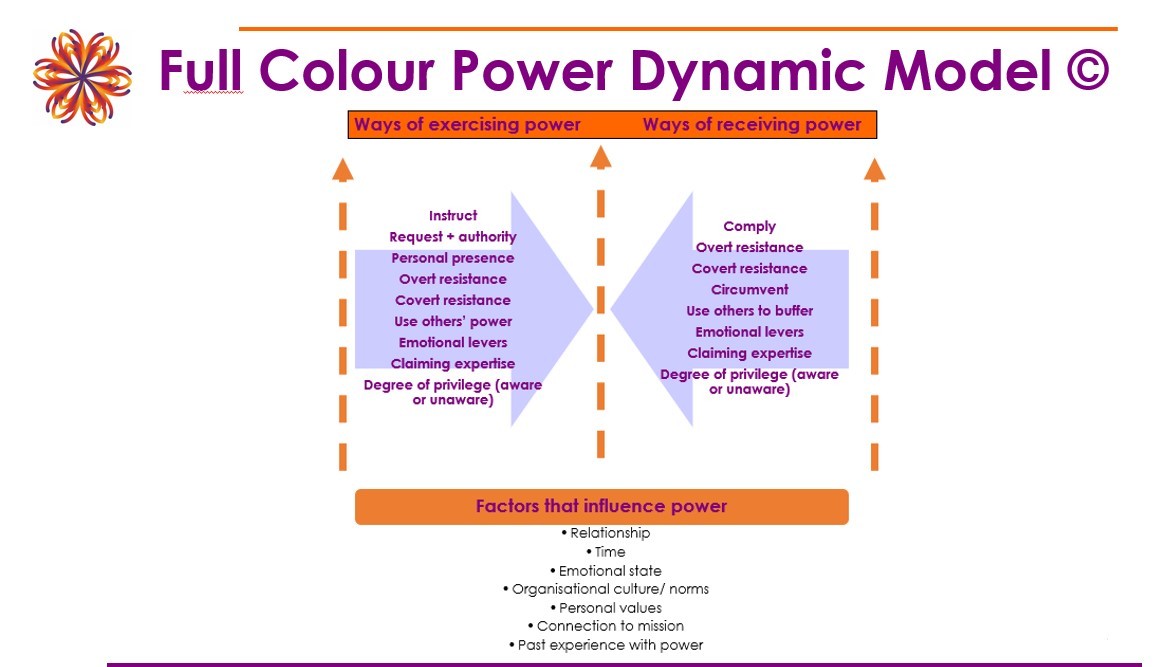Power is at the heart of equity, diversity, inclusion and equality. Yet few of us, particularly those with power, ever stop to examine how it works in their organisation. If you can’t articulate how power functions specifically in your organisation, how can you address the imbalances that hold back progress on EDI?
Let me be clear. We all work in hierarchical organisations and some degree of power imbalance is and will always be the norm. But how power works can disadvantage people in ways you don’t intend. Unless you examine your organisation, you can never identify what’s not working, let alone address it.
A couple of weeks ago I shared a model by French and Raven about five sources of leadership power. However, this model, like most others, makes a big assumption: that power is exerted by some and passively received by others.
In my experience power is not static. It is a dynamic force which is as much affected by how it is received as how it is exerted.
That’s why I created the Full Colour Power Dynamic Model©: to help leaders identify and articulate how power works in their organisations so they can begin to address inequity and inequality.
Why do we need to understand power dynamics?
I have yet to meet anyone who experienced a major organisational change programme and raved about how well it went.
Despite all the grief and turmoil, change programmes often achieve a fraction of their intended outcomes, e.g. shifting culture to eliminate silo working.
The result:
- Wasted money
- Wasted effort
- Staff who abandon your ship in search of calmer waters
- Loss of trust
- People working to undermine the change you seek
I’m sure you could add to the list…
A big reason change programmes fail is that leaders often think in two dimensions when planning them:
- Who do we need to consult?
- What deadlines do we need to meet?
Both are valid questions. However, they only scratch the surface of what leaders – particularly HR leaders charged with devising and executing change plans – need to think through to have a genuine shot at success.
How power works in your organisation is one of the core things you should be mapping before you even whisper the term “change”. Who really holds power? How is power exercised in the real day to day life of your organisation? How does this affect people, particularly those with minoritized characteristics? How will existing power dynamics affect your change plans?
Full Colour Power Dynamic Model ©
This is where the Full Colour model comes in. It sets out different elements that make up an organisation’s (or a team’s) power dynamic.

Please credit Full Colour in using this model
There are three elements to the model:
Factors that affect or underpin power dynamics, e.g. existing relationships, time, emotional state, organisational culture etc
The way power is exercised, e.g. through instruction, positional authority, being persuasive and articulate, conscious or unconscious use of privilege etc
The way power is received, e.g. compliance, passive resistance, use of others’ power to act as a buffer etc.
Mapping how these three elements work in your organisation is crucial if you are to design a change programme that delivers results, and avoid unintended EDI consequences.
Think you don’t have time to map this out? Think again. Failing to work out power dynamics in advance will slow you down, throw up roadblocks you could have anticipated, and increase your risk of failure.
Many of us have heard the phrase “failing to plan is planning to fail”. Here’s another one for you.
Abraham Lincoln once said: “give me six hours to chop down a tree and I’ll spend the first four hours sharpening the axe”.
If you found this Full Colour Friday edition helpful, do share. Feel free to use the Full Colour Power Dynamic Model but please credit us if you do.
Are you going through change? Want to approach it with EDI at the heart of your plans? Then reach out on info@fullclr.com.

